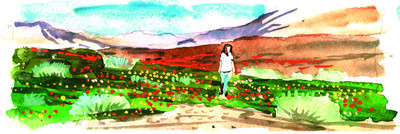Death Valley’s wildflower show should be better than usual
Intermittent winter rains in the desert promise wildflowers in the spring. In our area, late autumn rains brought the inch of rain needed to trigger seeds to sprout in some areas, encouraged by mild to warm temperatures in January. Rain and snow from following storms furthered the tender greening on the desert. Winds carrying moisture did not dry out the seedlings. The conditions add up to a better than average wildflower show, but you have to know where and when to look.
Springtime shows up early in Death Valley National Park, but extensive wildflower displays are not an annual event. This year, park rangers noticed the first greening weeks ago in the lower elevations on the valley floor and alluvial fans. A few flowers tentatively appeared by early February.
Encouraged by late rains, the wildflower show began to spread, but rangers predict a later peak for the blossoms, likely from mid-March to early April. Although not a banner year like 2005 when the pollen from the massed flowers filled the desert air with a yellow haze, the 2009 display will reward those traveling to Death Valley this spring.
The closest national park to Las Vegas, Death Valley lies about 150 miles away by the shortest route through Pahrump to Bel Vista Road to Death Valley Junction at Highway 190, the road to Furnace Creek. Other somewhat longer approaches include Highway 374 through Daylight Pass from Beatty on U.S. 95 and Highway 178, the Salsberry Pass-Jubilee Pass Road from Shoshone, Calif.
When planning a wildflower watching trip to Death Valley, loop through the park to see more territory. Roadside wildflowers will vary with elevation and terrain. Since rainwater flows off the asphalt onto gravelly roadsides and the asphalt retains seed-generating heat, the flowers often show up first and best close to the roadways themselves.
Often the passes traversed to get into Death Valley National Park feature some of the more rewarding displays of blooming desert plants. They seem to like rocky areas where boulders provide shelter, retain the sun's heat and help the soil hold moisture. Look for the earliest flowers to appear on south-facing slopes of hills, arroyos and highway embankments, particularly in these passes.
Travelers easily spot the dominant species such as primroses, verbena, phacelia, sunflowers, poppies and blazing star. You'll have to park safely off the highway and walk a little to enjoy some of the lesser flowers, often called "baby flowers," which will put on delightful displays in miniature.
Take a camera, preferably with a zoom lens, as the flowers seem to arrange themselves in postcard scenes just for your enjoyment. With digital technology, you can store your springtime memories long after the blossoms have gone to seed to wait for another good year to bloom again.
A few common sense rules apply to successful wildflower enjoyment. Explain to children that they should resist the urge to pick wildflowers because they don't last like garden flowers and picking them destroys their ability to produce seeds. Try to tread lightly upon the landscape full of flowers. Be careful where you put your feet and hands for yet another reason: You aren't the only creature apt to be enjoying the spring sunshine; snakes and insects may be, too.
If you like to be able to put names to what you observe in bloom, this is the year to invest in at least one good illustrated guide to desert wildflowers. You could start by pursuing the collection of guide books available at the visitor center and at other shops in Death Valley at Furnace Creek, Stovepipe Wells and Scotty's Castle, as well as in portal towns such as Beatty and Shoshone.
Look for easily held books with clear color photos. Some are arranged by color of blossoms, easy to use when you are in a hurry. Some guides are specific to a region, only marginally helpful when you aren't in that region, while others are so general as to leave you guessing. As a result, you may end up with more than one or even, eventually, a shelf full of guidebooks.
Margo Bartlett Pesek's column appears on Sundays.






















